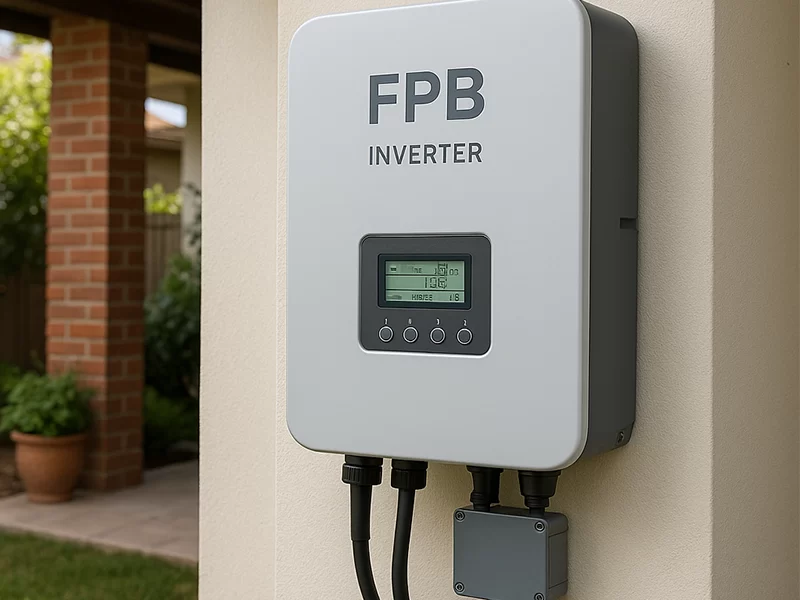What is An FPB Inverter?

Flexible Power Boost Inverters are leading power conversion appliances for higher energy efficiency in renewable energy systems. Solicitations for FPB inverters have accelerated for residential, commercial, and industrial applications as worldwide solar installations are predicted to exceed 2.3 TW by 2030. These articles present a technology-by-technology-assisted perspective on the advantages and performance from real applications backed by tracking data.
1. What is an FPB Inverter?
The function of FPB inverters is to convert the direct current (DC) power from solar panels or batteries into alternating current (AC) for grid or off-grid applications. Unlike conventional inverters, the modular design and smart energy management work in a fully integrated way to achieve conversion efficiencies as high as 98.5% (standard models typically achieve 96%).
Key Components
| Component | Function | FPB Advantage |
| MOSFET Transistors | Switch DC to AC | High-frequency switching (165A/60V) reduces heat loss |
| MPPT Controller | Track maximum power point | 99.9% tracking accuracy in low-light conditions |
| Cooling System | Prevent overheating | Liquid cooling extends lifespan by 30% |
2. Why Choose FPB Inverters?
Technical Advantages
| Feature | FPB Inverters | Traditional Inverters |
| Efficiency | 98.5% | 92-96% |
| Operating Temperature | -25°C to 60°C | 0°C to 50°C |
| IP Rating | IP65 (dust/waterproof) | IP54 |
| Response Time | <10ms for grid shifts | 20-50ms |
Case Study: A 100kW FPB system in Dongguan, China, reduced a factory’s monthly energy costs by 28% ($1,200 savings) through peak shaving.
3. Applications Across Industries
Performance by Scenario
| Application | FPB Inverter Role | Data Outcome |
| Residential Solar | Self-consumption + grid sell-back | 5kW system cuts annual bills by $800 (ROI: 4 years) |
| Industrial Plants | Load balancing during peak tariffs | 50kW system avoids $15k/year in demand charges |
| Off-Grid Emergency | Disaster recovery power supply | 48-hour deployment in Pakistan floods (2022) |
| EV Charging Stations | Stabilize grid demand | 30% faster charging vs. standard inverters |
4. Cost-Benefit Analysis
FPB vs. Diesel Generators (5-Year Cost)
| Cost Factor | FPB Inverter | Diesel Generator |
| Initial Investment | $5,000 (10kW) | $3,500 (10kW) |
| Fuel/Maintenance | $200/year | $4,800/year |
| CO2 Emissions | 0 tons | 18.5 tons |
| Total Savings | $21,500 | - |
Assumptions: Diesel price = $1.2/L, 8hrs/day operation.
5. Buyer’s Guide: How to Choose
Critical Parameters
| Parameter | Residential (5kW) | Commercial (100kW) |
| Input Voltage | 150-450V DC | 500-820V DC |
| Output Phase | Single-phase | Three-phase |
| Warranty | 10 years | 10-15 years |
| Certifications | CQC, TÜV, CE | IEC 62109, UL 1741 |
Pro Tip: For snowy regions (e.g., Heilongjiang), select models with -40°C cold-start capability.
6. Future Trends & Innovations
- AI Integration: Predictive Maintenance: Downtime reduced by 25% (by 2025 estimate).
- Hybrid Systems: FPB + hydrogen storage to run microgrids 24/7.
- Global Demand: FPB sales in Asia-Pacific to grow at a 14.2% CAGR (2024-2030).
FAQ Section
Q1: Do FPB inverters support older types of solar panels?
Yes. They have a wide DC input range (120 to 1000 V), which can accommodate most older panels (about 80%).
Q2: What is the average life of FPB inverters?
The average life is about 15 years as opposed to 10 years for a conventional inverter.
Q3: Are FPB inverters subsidized by the government?
Yes. In China, under the "Double Carbon" policy, users get $0.05/kWh.
FPB inverters have a new definition of energy efficiency through faster ROI, the harshest climates, and the best grid integration. Their modularity and compliance with global standards (IEC/UL) will continue to make those state-of-the-art in their use for sustainable energy transitions as adoption of solar grows.
Ready to Upgrade?
